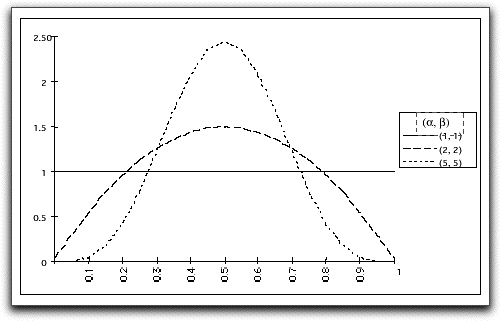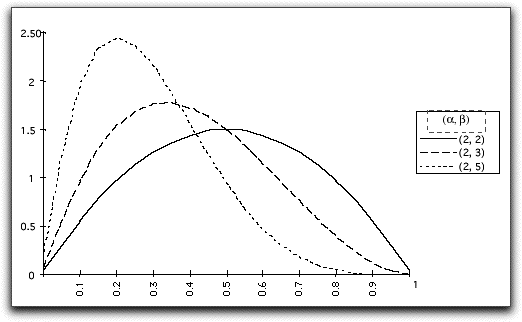|

Asymmetric distributions are obtained by choosing
alpha and beta to be different. The picture below shows several
cases with alpha held constant at 2. The greater the difference
between alpha and beta the greater the asymmetry. The asymmetric
examples are all skewed to the right because alpha is less than
beta. To obtain distributions skewed to the left choose alpha
greater than beta.

The generalized Beta distribution has a range
other that 0 to 1 and has the extra parameters defining the
minimum and maximum. The generalized Beta distributions look
the same as the pictures above but are spread out and/or shifted.
The notation for the generalized Beta distribution
and equations for the mean, variance and mode (or most likely
value) are shown below. The mode is interesting to project analysis,
because it is used as a parameter in the traditional analysis.
It is interesting to compare this with the traditional
PERT method for calculating the mean and variance. Here the
mode is a parameter. The Beta distribution allows much more
variety for the variance of the distributions.
The table below shows the mean, variance and mode
values for the five different Beta distributions pictured above
and compares the results with the traditional calculations of
the mean and variance. All have the range 0 to 1.
Alpha |
Beta |
Mean |
Variance |
Mode |
Trad. Mean |
Trad. Var. |
| 1 |
1 |
0.5 |
0.083 |
*** |
*** |
*** |
| 2 |
2 |
0.5 |
0.050 |
0.5 |
0.5 |
0.028 |
| 5 |
5 |
0.5 |
0.023 |
0.5 |
0.5 |
0.028 |
| 2 |
3 |
0.4 |
0.040 |
0.33 |
0.389 |
0.028 |
| 2 |
5 |
0.286 |
0.026 |
0.2 |
0.3 |
0.028 |
There is no mode defined for the uniform distribution
described by the first case. For the other cases the traditional
variance calculation yields the same result since it only
depends on the range. For asymmetric cases, the difference
between the Beta distribution mean and the traditional mean
increases as the distribution becomes more skewed.
For project analysis we may be given the mode
and require values of the shape parameters, alpha and beta,
to specify the Beta distribution. Formulas for two cases are
below. In each case we must choose one parameter and solve for
the other.
When the mode is equal to one of the limits, only
one of the equations is valid. |



